Tom's Hardware Verdict
The BlackWidow V3 Pro screams Razer, from its premium build and keycaps to its flashy RGB, media controls and included wrist rest. It’s a fantastic option as a full-sized wireless gaming keyboard, but it’s expensive and needs software to change the RGB.
Pros
- +
Doubleshot keycaps feel premium, resist smudges
- +
Satisfying multi-function dial and media keys
- +
Premium wrist rest
Cons
- -
Expensive
- -
Finicky when battery is very low
- -
No macro keys
- -
RGB is too software dependent
Why you can trust Tom's Hardware
Sometimes the best wireless keyboard is one that’s small and petite. That makes it good for traveling, moving across different systems and small desks. But what if you want all the thrills and functionality of a full-sized, full-featured mechanical keyboard but just want to ditch the cable?
The Razer BlackWidow V3 Pro ($230 as of writing) boasts many features of the best gaming keyboards, including a full set of media keys, RGB and even a quality wrist rest. But it also cuts the cable, allowing gamers to connect via a 2.4 GHz USB dongle, Bluetooth 5.0 or a braided cable when it needs to charge. This is the keyboard for the gamer who wants it all but the wire.
Razer BlackWidow V3 Pro Specs
| Switches | Razer Green or Razer Yellow |
|---|---|
| Lighting | Per-key RGB |
| Onboard Storage | Up to 4 profiles |
| Media Keys | Yes |
| Connectivity | 2.4 GHz USB Type-A dongle (Razer HyperSpeed), Bluetooth or USB Type-A |
| Cable | USB Type-A to USB Type-C, braided, detachable |
| Additional Ports | None |
| Key Caps | Doubleshot ABS |
| Construction | Aluminum top plate, plastic base |
| Software | Razer Synapse 3 |
| Dimensions (LxWxH) | 17.7 x 9.8 x 1.7 inches (450.7 x 248.4 x 42.3mm) |
| Weight | 3.1 pounds (1,423g) |
Design
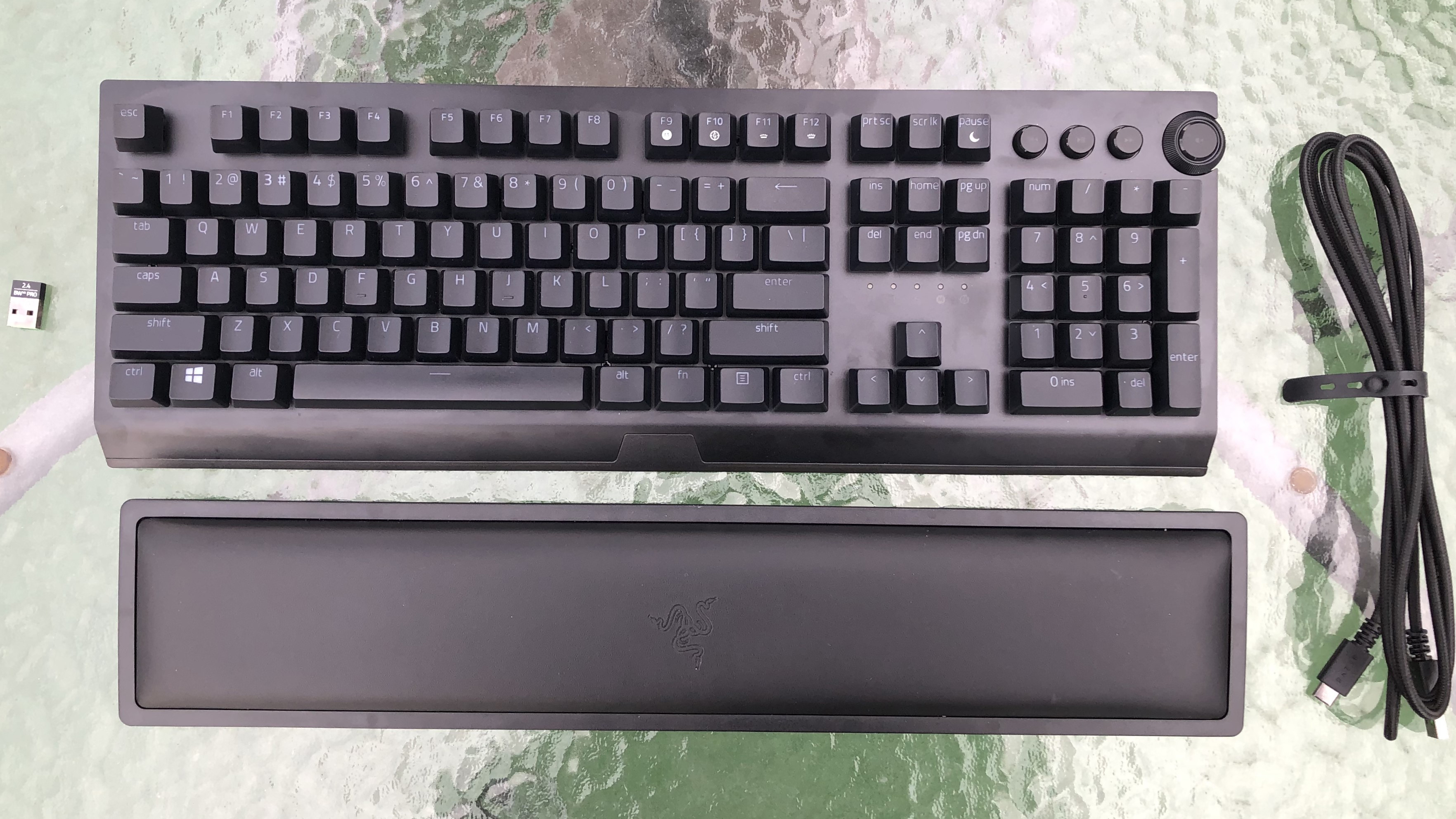
The BlackWidow V3 Pro looks like many of Razer’s keyboards. Take its showy media dial or the slithering snake emblem on the bottom of the keyboard and its included plush leatherette wrist rest. Overall, it’s a simple, all-black build boasting a sturdy aluminum top plate and plastic base. Most of this keyboard’s flash comes from the RGB, which Razer’s never been too shabby at but has upgraded even further by debuting transparent versions of its mechanical switches that are supposed to help the LEDs shine through more.
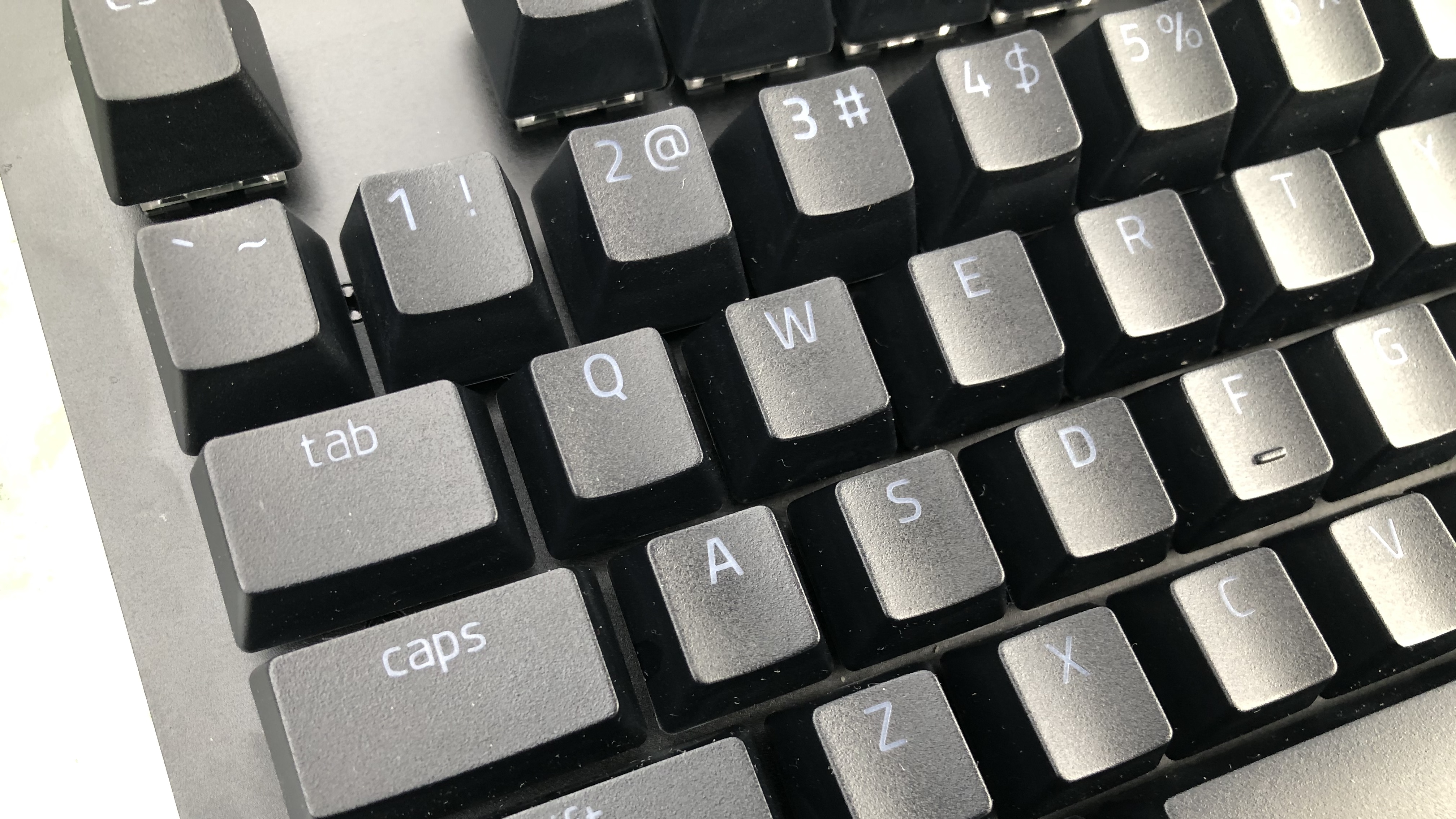
Aiding the mission for tasty RGB is the keycaps’ font, which strikes a good balance between serious and fun with round, friendly loops and thin letters. Having things like Caps and Shift in lowercase letters keeps the vibe light, without looking silly. The thin font also makes the RGB pop against the black, doubleshot ABS plastic keycaps that look and feel nearly as premium as PBT and did a good job of resisting fingerprint smudges after a week of heavy use -- although the aluminum top plate isn’t so lucky.
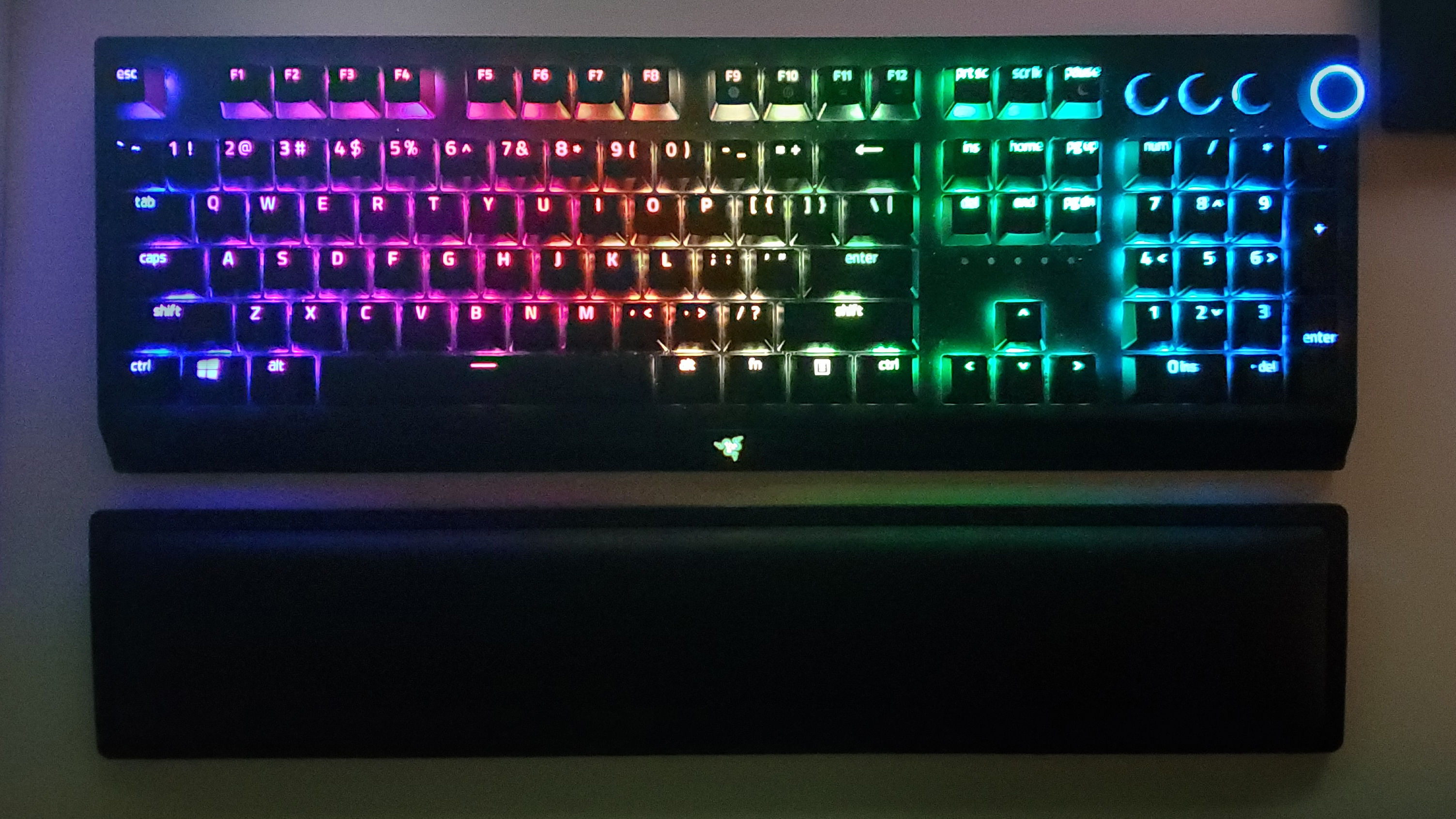
RGB bleeds between the well-spaced keys for a glow throughout that shines on the south side of the function row at brightness settings as low as 20%. Note that you can adjust RGB brightness and turn it off with the keyboard and can also hold FN, Ctrl and 1-7 to toggle through RGB presets.
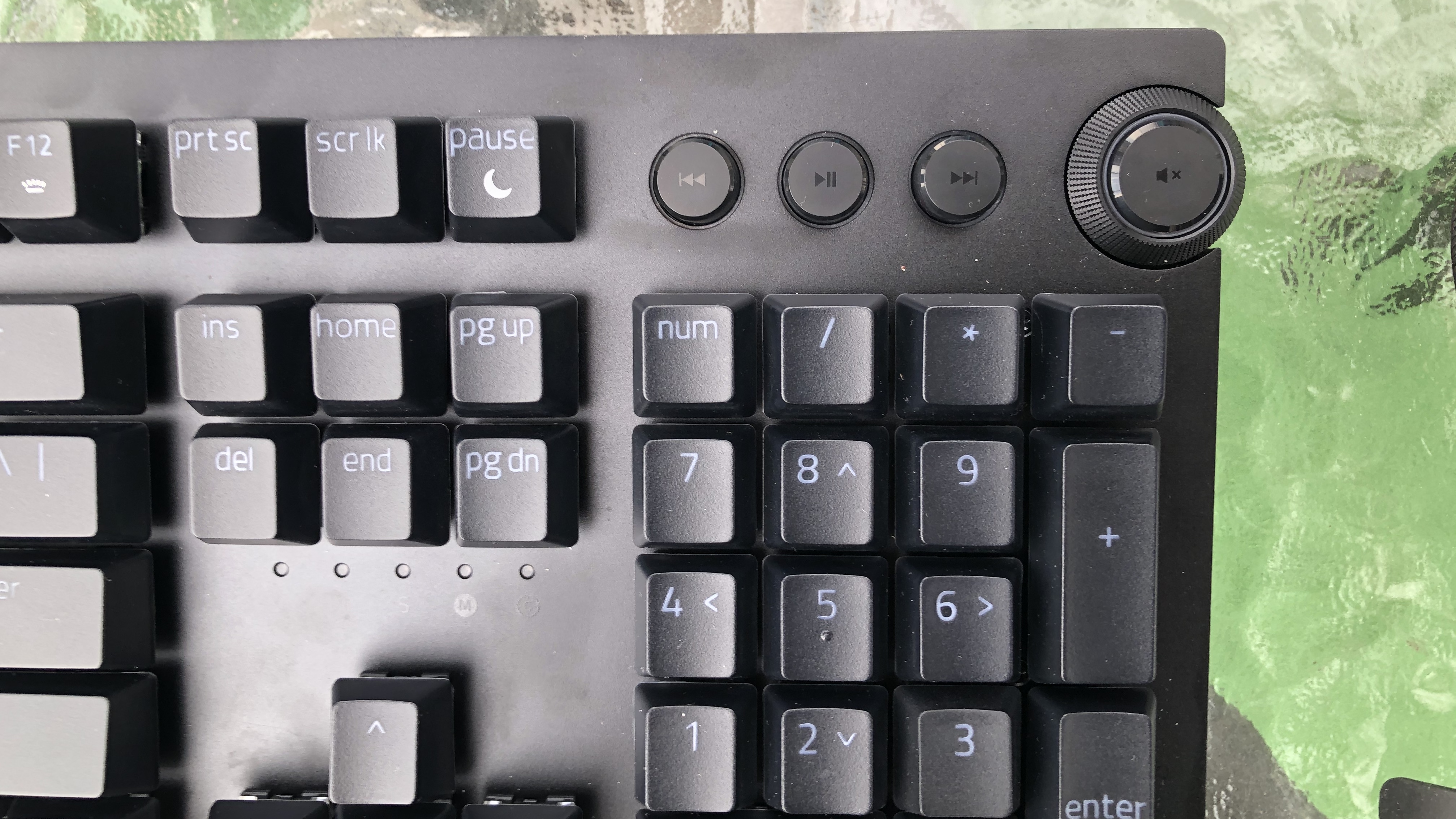
A standout volume wheel also brings flair, but for how expensive this keyboard is I wouldn’t have minded extra pizazz. The wireless Logitech G915 Lightspeed, with its brushed-aluminum top plate and matching volume wheel and soft-touch buttons looks more expensive and special at first glance. The Razer RGB logo is a given, but it intersects the aluminum top plate and lives behind textured plastic that takes away from the subtly aluminum finish and makes the snake emblem look a little blurry.
Admittedly, many gamers will rejoice to see the keyboard’s potential for subtlety. And there are still premium touches. The wrist rest, (which the Logitech rival omits), is well-cushioned. Many freebie wrist rests are flimsy pisces of plastic I’d immediately toss aside in favor of my HyperX Wrist Rest. But the wrist rest here puts up a good fight. It’s not the same luxurious and cooling memory foam but it's comfy, and the leatherette feels nice on the wrists.
Like the wired Razer Huntsman Elite, the BlackWidow V3 Pro sports one stylish volume wheel that lights up with RGB, offers tactile control, a frosted press-in center, and juts out of the keyboard’s side for a daring shape. Adjusting the wheel changes volume by two steps and feels like DJing. The wheel also provides extra functionality as a programmable button. The three media buttons accompanying it also stick out proudly and feature a smooth plastic finish. The symbols on thmn, however, are hard to read, especially if you’re in a well-lit room. Speaking of which, the icons south of the navigational keys are also difficult to discern.
The BlackWidow V3 Pro is wireless, but that doesn’t mean it’s travel-friendly. It’s the same size as a typical full-sized wired keyboard at 17.7 x 9.8 x 1.7 inches and 3.1 pounds. The keyboard’s biggest rival is Logitech’s G915 Lightspeed (18.7 x 5.9 x 0.87 inches, 2.3 pounds), which stays trim with low-profile switches.
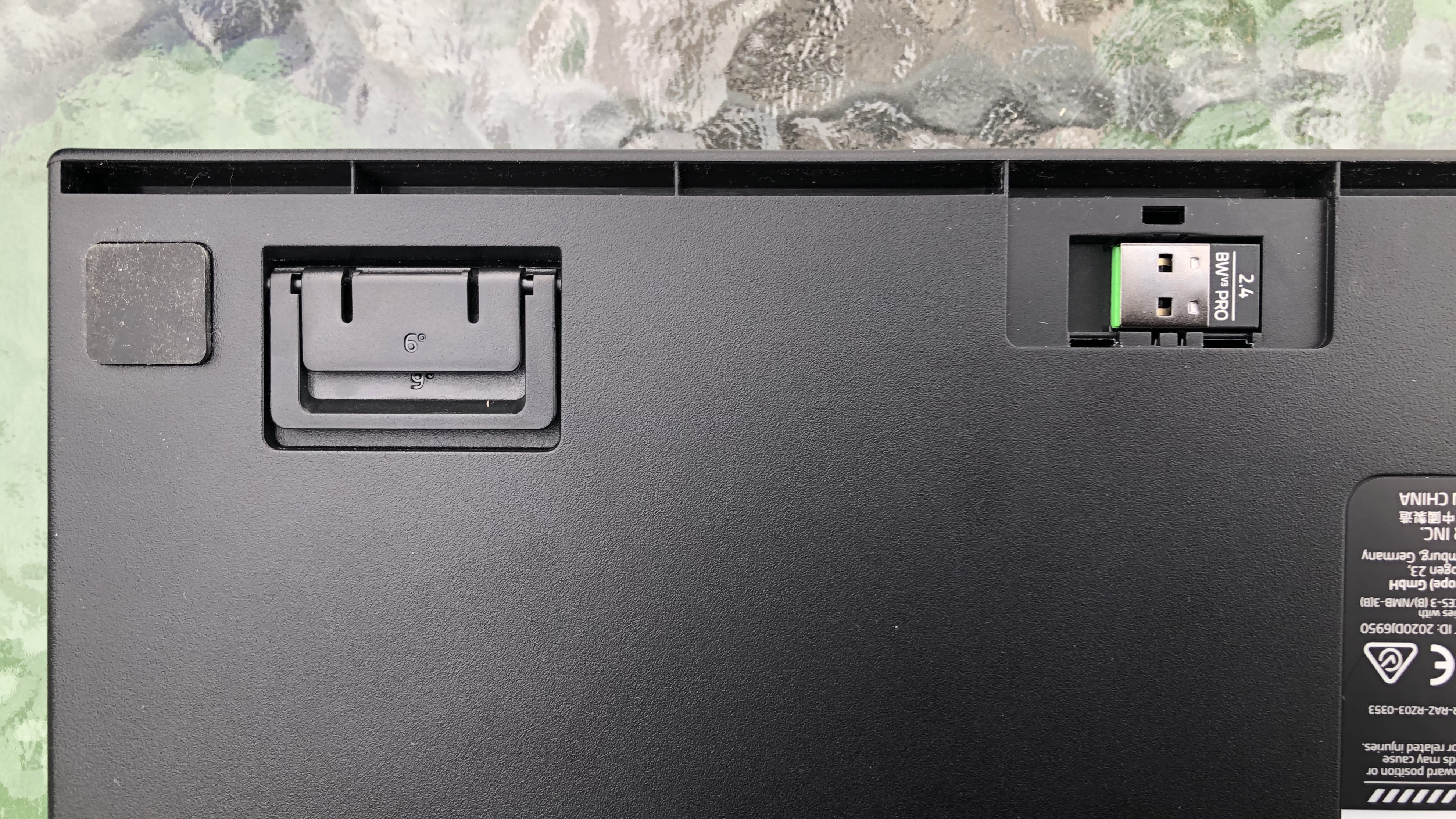
Razer thoughtfully included dongle storage on the keyboard’s underside, and the dongle is aptly inscribed, so you’ll always know what it’s for -- unless you have a plethora of wireless Razer gear. The keyboard’s underside also has flip-out feet for 6 or 9 degrees of elevation, another thoughtful touch.
Wireless Experience
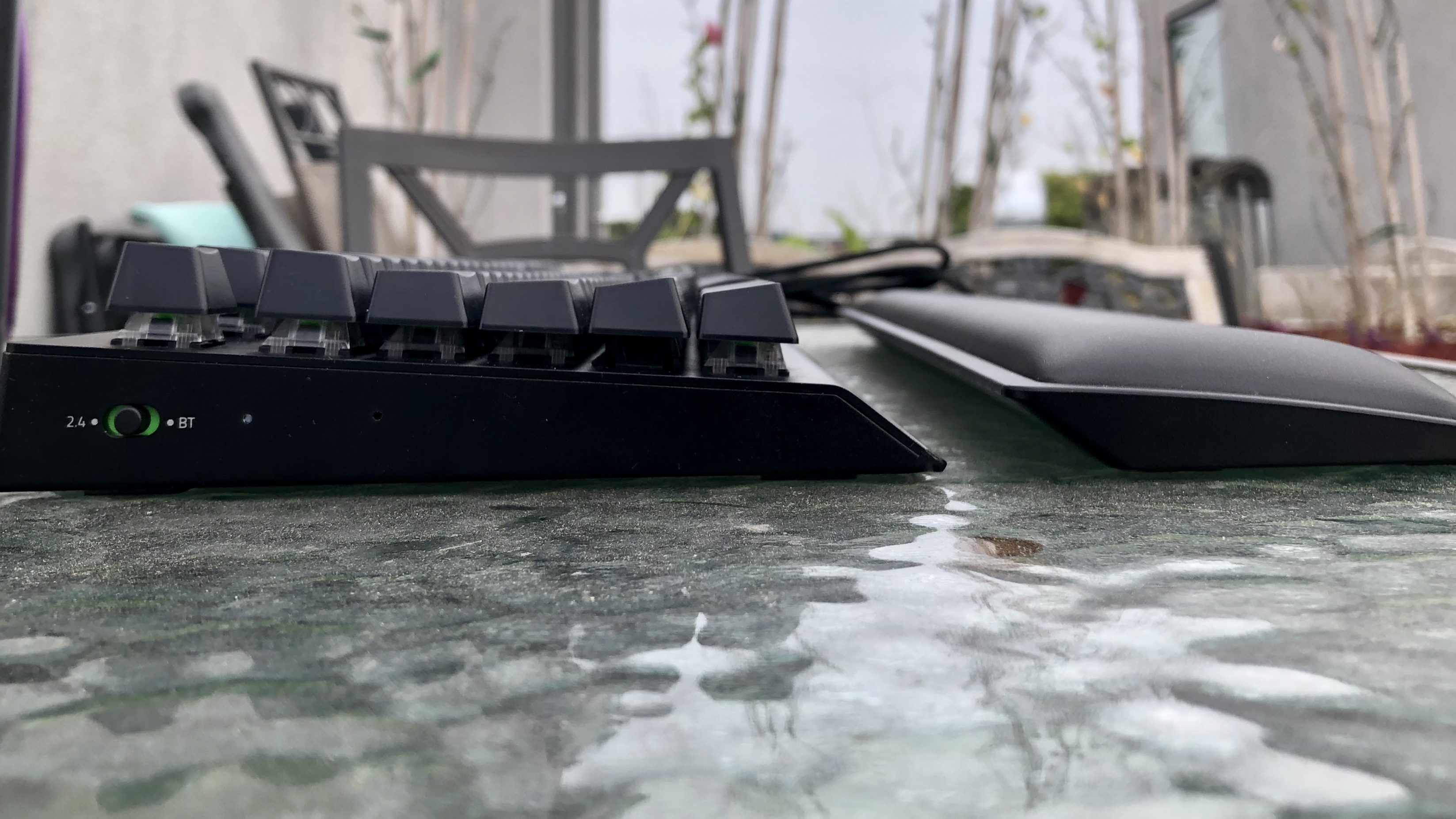
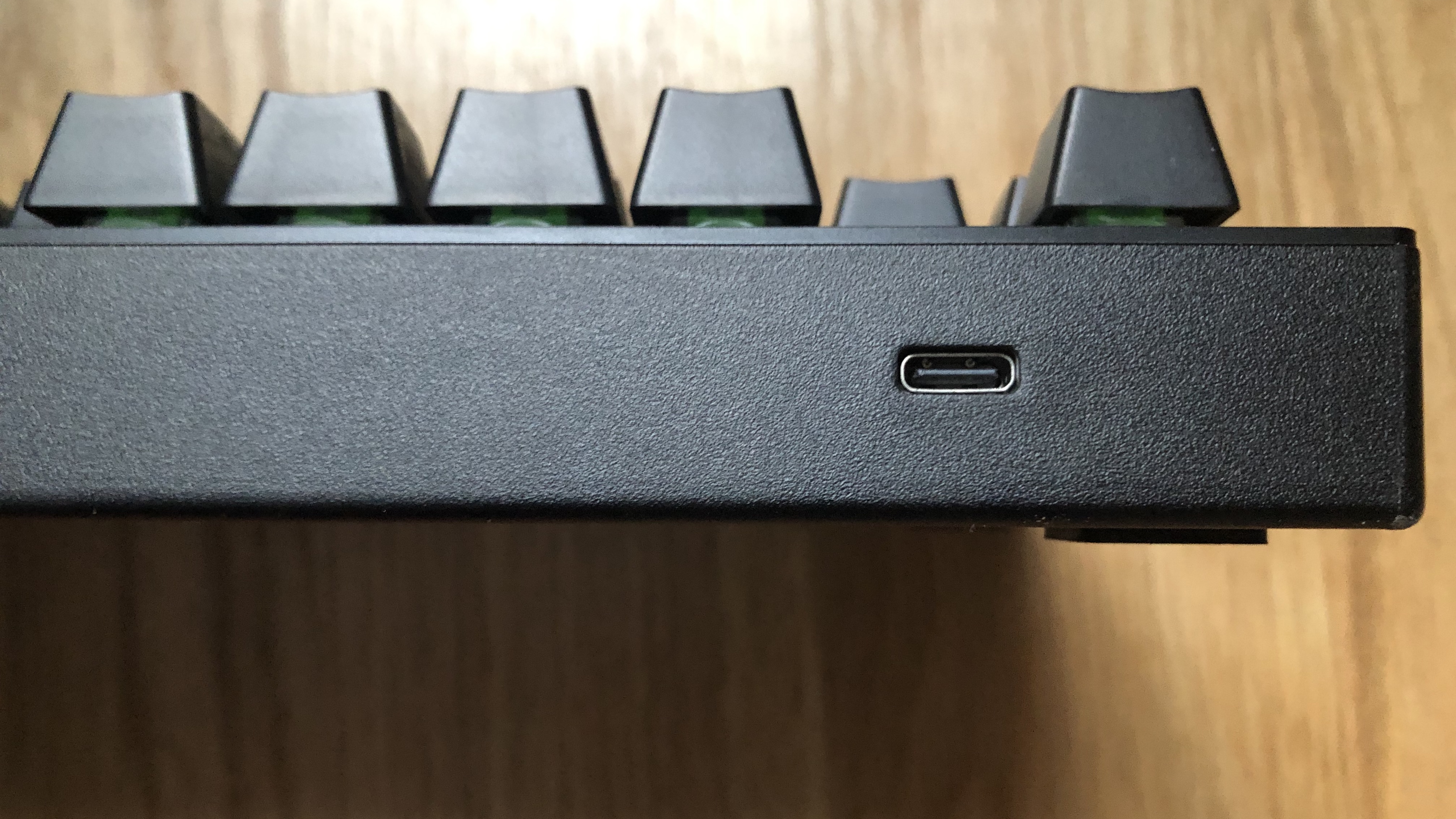
Although the keyboard’s not easy to lug around, Razer makes it easy to pair it with multiple PCs. A solid toggle that won’t accidentally get hit on the left side makes it easy to switch between systems. You can opt for the 2.4 GHz dongle connection, a Bluetooth one or the detachable, braided USB-C cable. I also successfully paired the clacker with up to three Bluetooth devices and jumped around by hitting FN and 1, 2 or 3, making the keyboard a decent, but heavier, option for productivity or bringing into the living room. Unlike with many wireless gaming peripherals, you can even control the BlackWidow V3 Pro with software when paired to your PC via Bluetooth. After 13 hours of using the keyboard in Bluetooth mode while also using a wireless mouse, the keyboard suddenly connection three times-- each time was after a few minutes of inactivity. Your mileage may vary, and it could’ve been an issue with my computer, but I’ve never experienced this when using a Logitech G915 TKL’s Bluetooth connection with this same PC, (and my mouse’s Bluetooth connection didn’t drop).
For gaming though, the HyperSpeed dongle connection is recommended. Razer claims up to a 25% boost in speed over “any other wireless gaming technology,” as per the TUV SUD certification institute. The connection served reliably on the battlefield, even when also using my best wireless mouse and occasionally a 2.4 GHz headset, too. I did suffer lag when battery life was at 3% or lower. At this point, the keyboard enters a low battery mode that makes RGB dim and erratic and resulted in 1-2 second delays before registering my key presses.
Typing Experience
The BlackWidow V3 Pro features tactile and clicky Razer Green or linear and silent Razer Yellow (3.5mm total travel, actuating at 1.2mm with 45G of force) mechanical switches. Razer updated the latter for the Blackwidow V3 Pro with non-removable silicon dampeners to ensure true silence. Our review unit has Green switches, which are similar to Cherry MX Blue switches -- loud and proud.
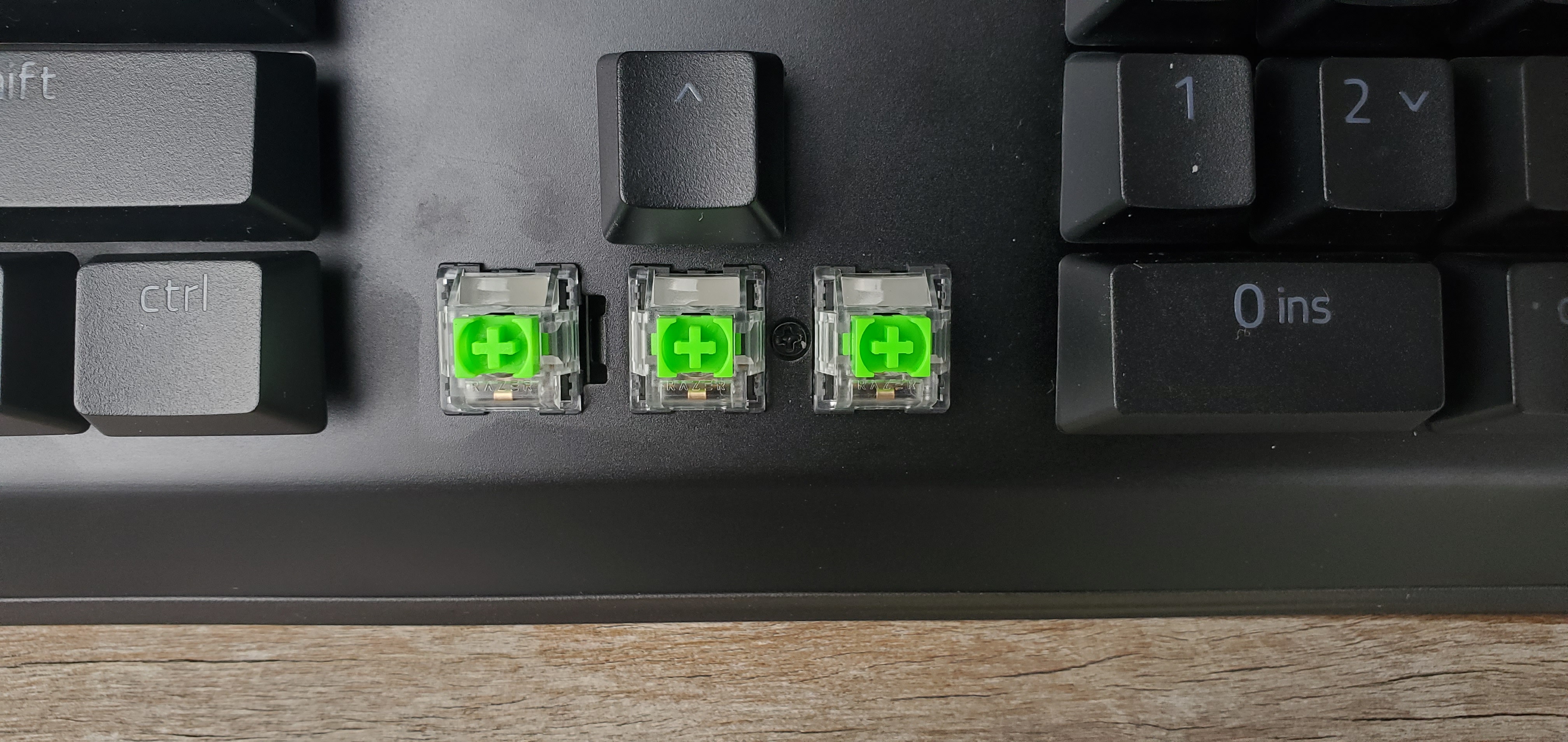
Razer’s Green switches have 4mm total travel and actuate at 1.9mm with 50G of force. That makes them a little lighter and quicker to actuate than Cherry Blues (4mm total travel actuating 2.2mm with 60G). In a side-by-side comparison, they feel familiar, but Cherry’s switches take a noticeable (if you’re keen on this type of thing) amount more force to depress. Both switches have a discernible bump along the way, but the Razer Greens seem to travel back up over that bump with more pop. If you like Cherry MX Blues or similar switches, you should like Razer Greens.
But more than anything, these switches are loud. When you hit the actuation point there’s a snappy, plastic-y click, followed nearly instantly by the sound of the keycap popping back into place. Despite the BlackWidow V3 Pro’s aluminum top plate, there isn’t much of an echoing ding, like you’ll hear in such as the SteelSeries Apex Pro. But like many mechanical keyboards, the spacebar is much louder. I heard a solid thock as I frequently bottomed out. Meanwhile, big keys, such as backspace, offered a more hollow thud that overpowered the switches’ click noise and snapped back quickly and heavily. When typing, my “home office” sounded like the only place in the apartment with a tin roof being bombarded with various-sized raindrops.
One of the most impressive things about the BlackWidow V3 Pro is its keycaps. The doubleshot ABS feels and looks premium, boasting a healthy amount of texture that you can see if you look closely. They're so well-made that you might mistake them for PBT. PBT plastic keycaps have even more texture, but these doubleshot ABS keycaps come respectably close and resist fingerprint smudges much better than standard ABS ones on many other mechanical keyboards.
The combination of clicky, lighter switches, quality keycaps and well-distanced and shaped keys made for efficient, pleasant typing. On the 10fastfingers.com typing test, I averaged 125.7 words per minute (WPM) and 97.6% accuracy, compared to my typical 115 wpm and 98% average. I attribute the speed boost to the key’s snappiness and the booming clacks cheering me on.
Gaming Experience
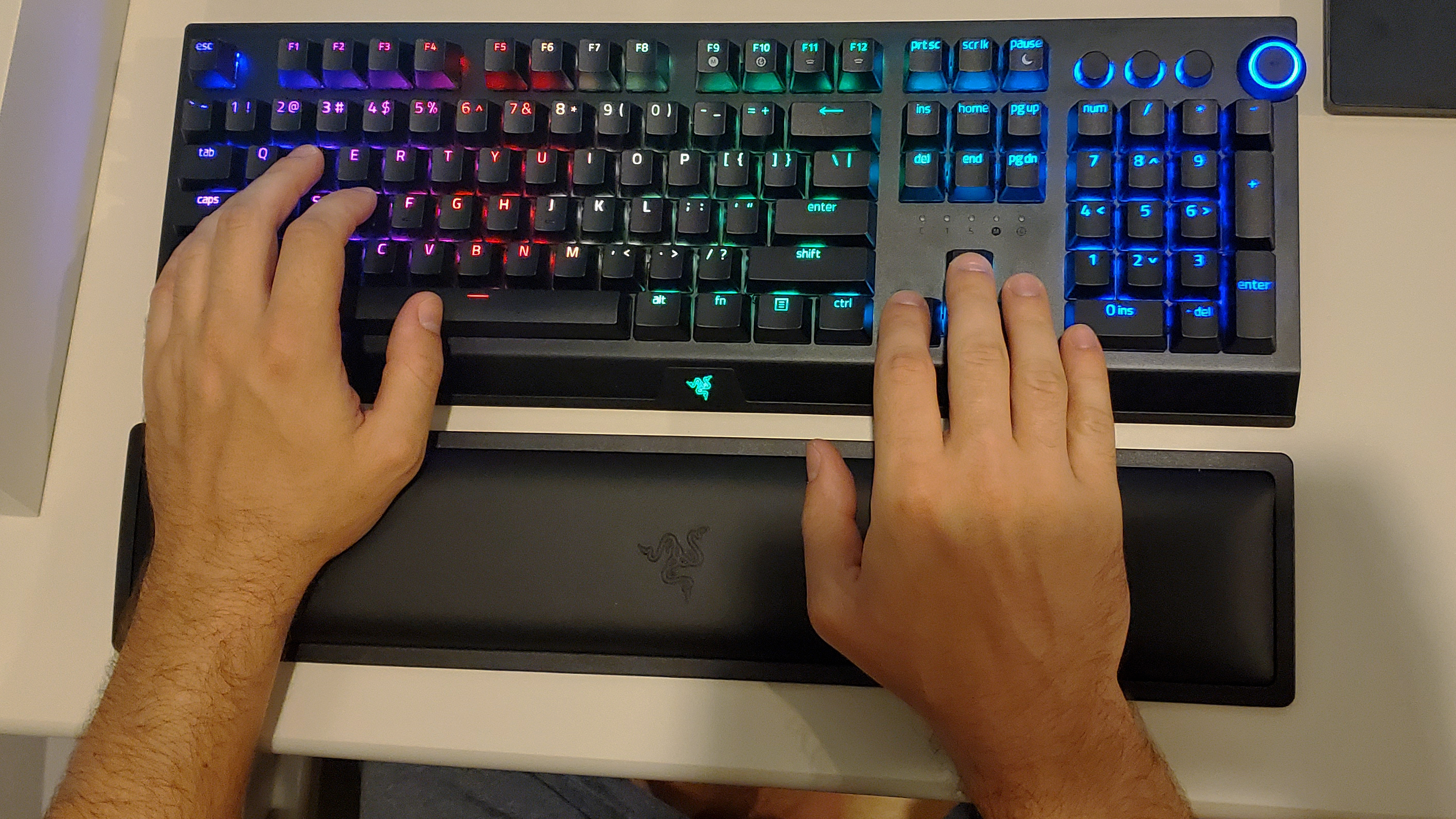
The BlackWidow V3 Pro fared excellently on the battlefield. I used Razer’s HyperSpeed dongle for gaming, since it’s supposed to provide a more reliable, lag-free connection than Bluetooth.
With MMO games it was a thrill to input different key combinations, and the well-spaced keys made it easier to know which button I was hitting without having to take my eyes off the screen. However, Razer's Green switches are so loud that they can be distracting, especially when you can hear them despite loud explosions and laser blasts. If your teammates can hear you, they’ll probably have some opinions too.
With Borderlands 3, I again found myself appreciating the resistance offered by the textured keycaps. That let my fingers stay in place on keys without slipping and quickly jump to a new key when handling hordes. If you’re focused on pressing the same button super-fast repeatedly, the linear version of this keyboard would be advantageous. Still, the Razer Green switches spring back into place eagerly to help with quick input.
Razer’s included wrist rest earns a special shout-out, helping me stay comfortable and focused on the game and playing longer. Other features gamers will appreciate include n-key rollover and on-the-fly macro recording. If you’re comparing this to Logitech’s G915 Lightspeed though, you’ll miss the extra G keys.
Battery Life
I set the keyboard’s RGB to max brightness and shifted between (depending on my task) a rainbow wave or static color. Out-of-the-box, it’s programmed to turn off after 15 minutes of inactivity. With these settings, my review unit averaged a little over 14 hours before needing a charge. I could’ve extended battery life, however, if I let the RGB dim after not using the keyboard for 1-15 minutes. Razer makes this optional, unlike Logitech’s wireless rival, which claims 30 hours battery life with RGB at max brightness, but dims automatically after inactivity.
I didn’t have enough time before publishing to run the keyboard’s battery down with a Bluetooth connection, but after 13 hours of use via Bluetooth and RGB set to the same max brightness and the same settings as above, my BlackWidow V3 Pro had 18% battery left.
The problem, as mentioned above, is that at 3% battery life, the keyboard gets unreliable. My keyboard’s RGB would flicker between being a dim rainbow wave, dim static colors and off. Worse, there was a noticeable delay before registering keypresses, especially the first one after a moment of inactivity. Synapse also stopped being able to identify the peripheral. Razer told me this is all due to the keyboard being in low power mode, but it makes the keyboard a pain to use. Of course, once this starts happening it’s easy to plug in the keyboard’s removable USB-C cable and get back to business.
Razer claims up to 192 hours battery life if you use the BlackWidow V3 Pro without RGB. If you kick in the light show, however, that figure drops to 5-25 hours. Razer offered the following chart to provide an idea of how long you can expect the keyboard to last depending on the RGB settings.
| Brightness | RGB Effect | Claimed Battery Life |
|---|---|---|
| 50% | Spectrum Cycling | 25 hours |
| 50% | White Static | 14 hours |
| 100% | Spectrum Cycling | 13 hours |
| 100% | White static | 5 hours |
In addition to having power saving settings, Synapse has a nearly hidden battery meter that, thankfully, provides a precise percentage.
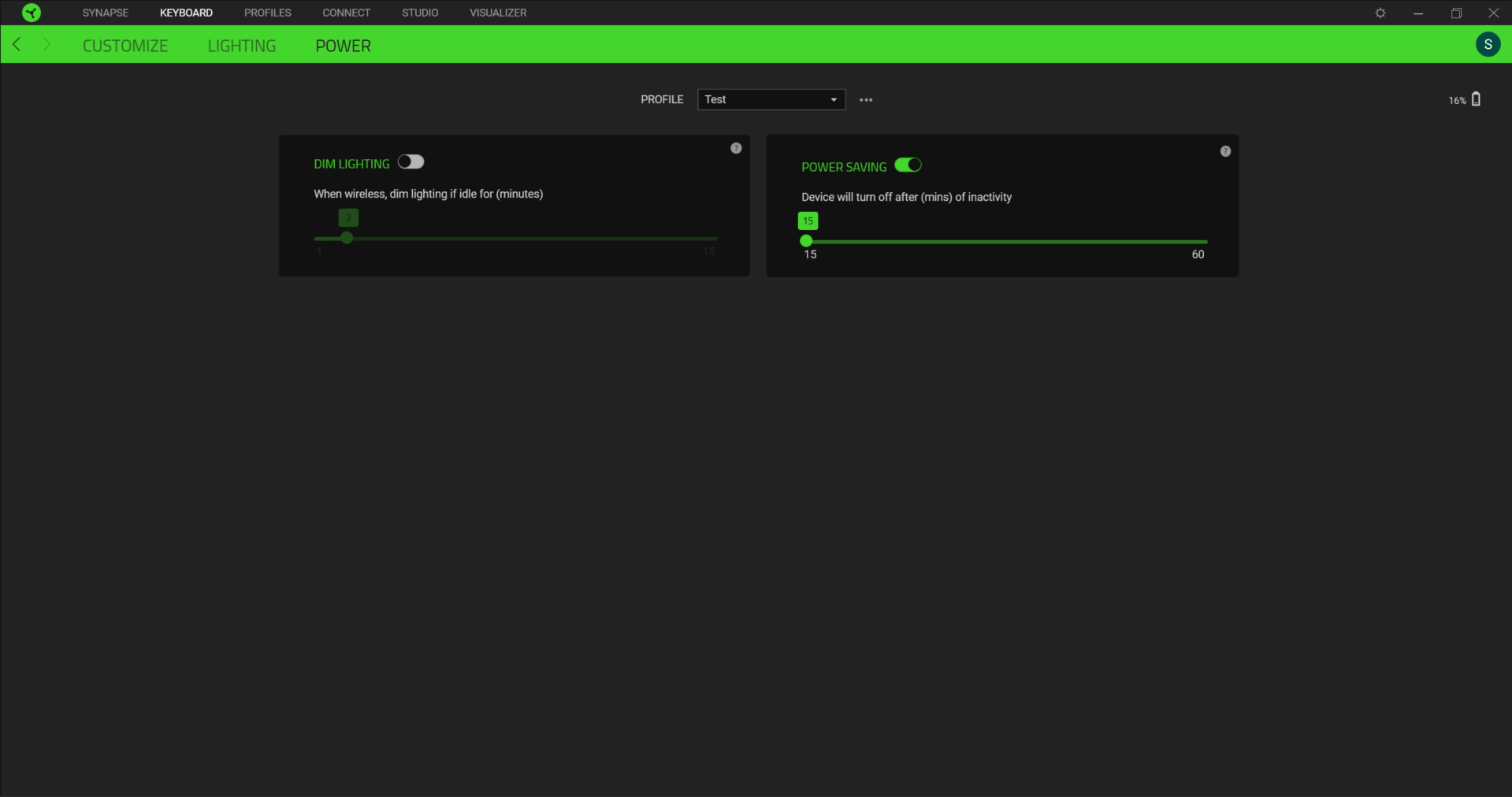
Features and Software
The BlackWidow V3 Pro is relatively feature-rich, but it depends more on the Synapse 3 software than I’d like. That’s not a horrible thing since Synapse is detailed and easy enough to use.
Although you get up to four profiles of onboard memory, RGB settings applied to each profile won’t carry over without the software open, and you need the software to create the profiles. That means if you want any RGB outside of the default 7 available for toggling, Synapse has to be running. The software occasionally stumbled and failed to change RGB settings even though Synapse showed otherwise. RGB is a luxury, and it’s possible that moving to another computer or other steps would have fixed this, but this sort of troubleshooting is exactly why it’s good to have RGB control that works without an app.
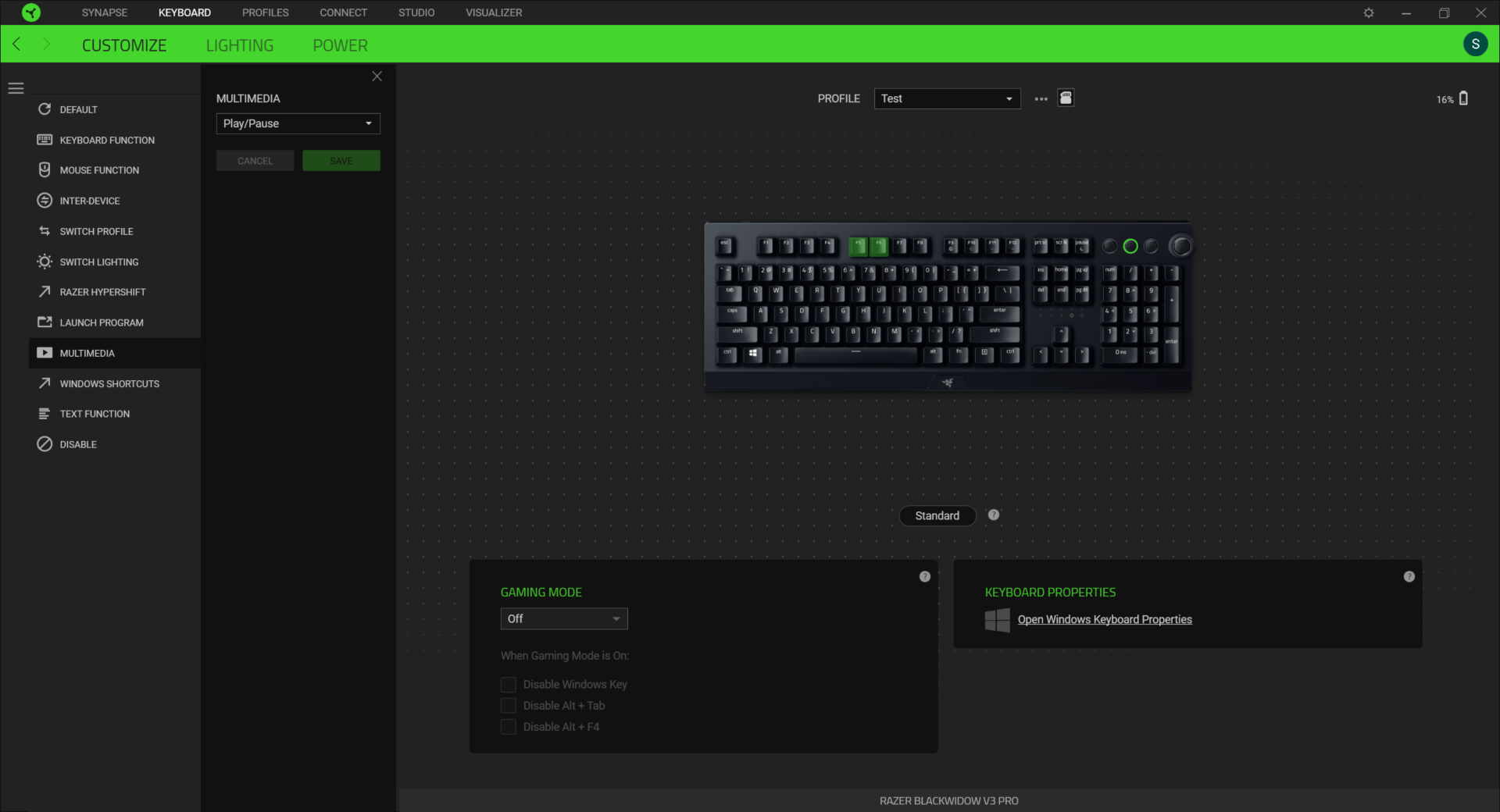
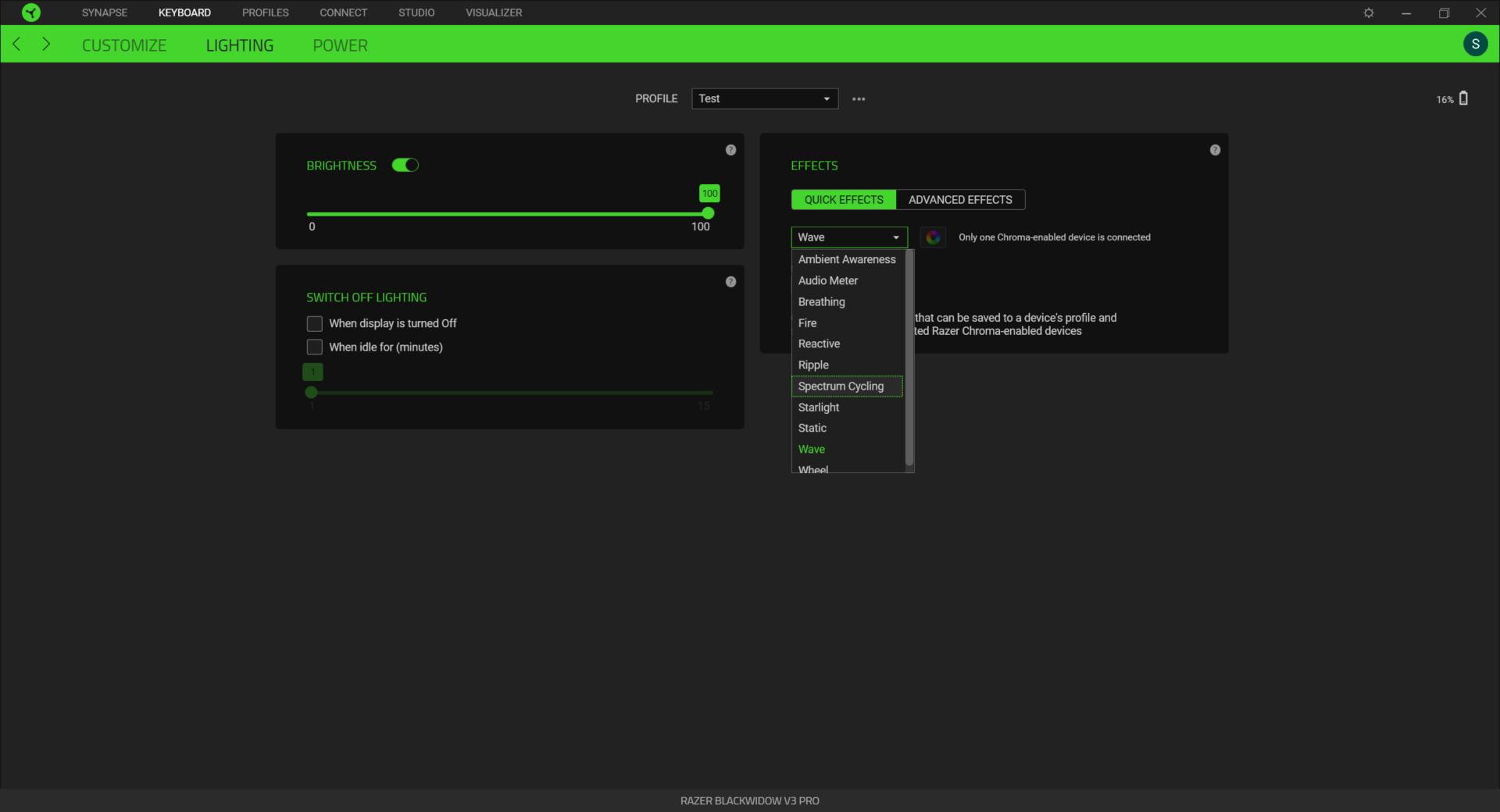
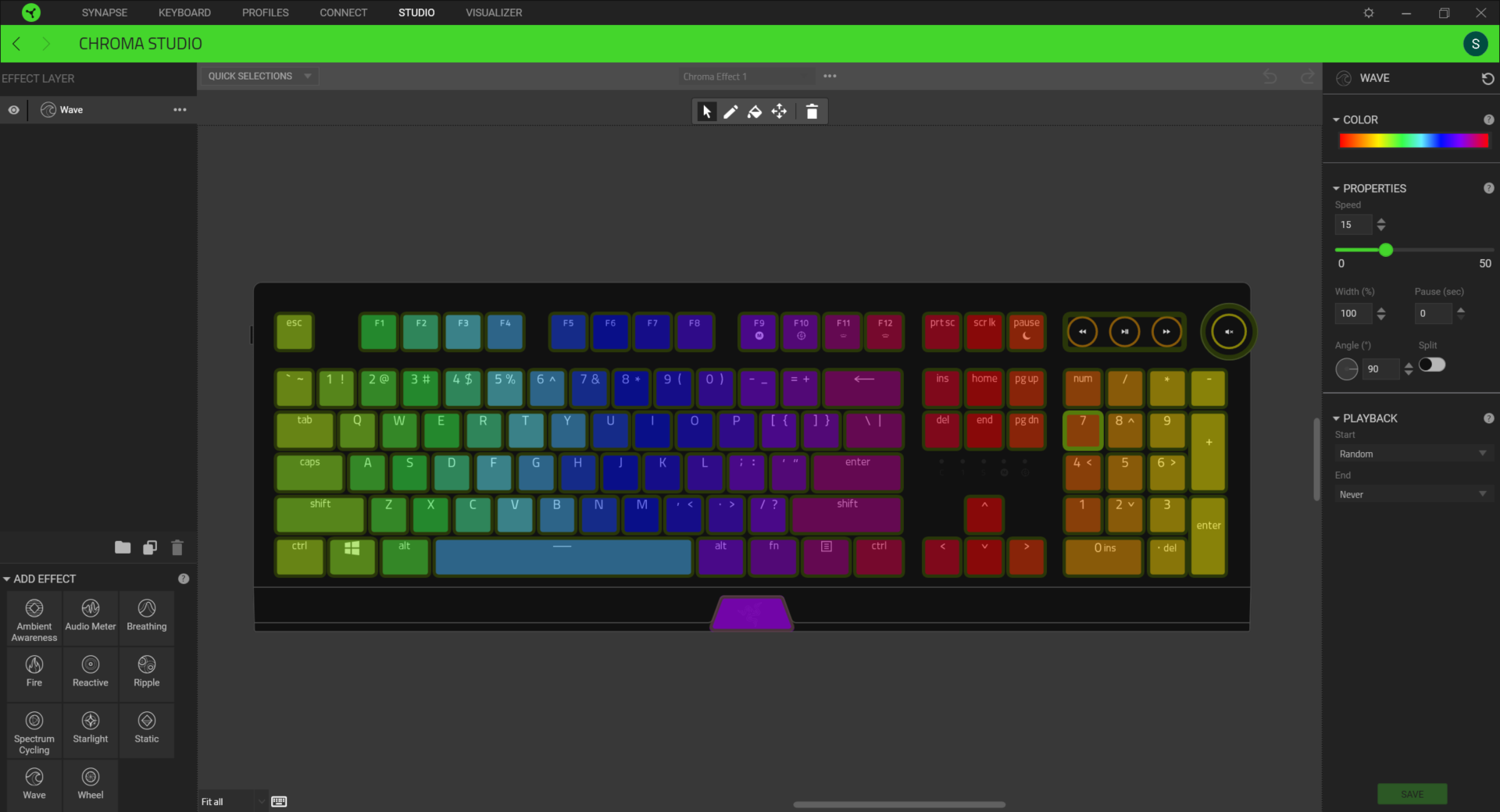
With Synapse you can change RGB brightness (you can also do this sans software) and tweak RGB behavior to cater to longer battery life. The software includes 10 premade RGB settings, including a rainbow wave and RGB that matches colors on your screen or reacts to audio. More advanced RGB fanatics can also program their own per-key settings via the Razer Chroma Studio part of the software
You can toggle through the keyboard’s onboard memory by hitting FN and Menu. In addition to the onboard memory, you can create profiles that are launchable with specific games and other applications.
Synapse also lets you reprogram every key except the Windows key and right FN key. Even all four media keys are reprogrammable, including the volume wheel in. With Razer’s Hypershift feature you get double the functionality. When you hold the right FN key down, every key can have an extra function. Razer made it easy to program various tasks, like open programs, Windows shortcuts and macros. The keyboard also offers on-the-fly macro recording.
Bottom Line
The Razer BlackWidow V3 Pro delivers on Razer’s reputation of high-end gaming. Despite its wireless connection, it proved as reliable as a wired keyboard, so long as battery life wasn’t on its last legs. From its doubleshot keycaps to alarmingly fun media wheel and well-made wrist rest, the keyboard does its best to earn its very high price tag.
But I’d love to be able to attach RGB settings to profiles stored in onboard memory. And at this price, it’d be handy to have some macro keys, like the Logitech G915 Lightspeed has, albeit at $20 more than our review subject (as of writing). Logitech’s wireless gaming keyboard also has a quiet tactile switch option, which the BlackWidow V3 Pro lacks, but you can only get it with low-profile switches.
For a full-sized wireless keyboard that has everything a wired mechanical has -- plus all the software, RGB and lavish touches, like per-key RGB and fancy media controls, that up the gaming experience -- the BlackWidow V3 Pro is hard to beat.
Scharon Harding has a special affinity for gaming peripherals (especially monitors), laptops and virtual reality. Previously, she covered business technology, including hardware, software, cyber security, cloud and other IT happenings, at Channelnomics, with bylines at CRN UK.
